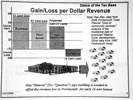Guestblog: Greenwood rebuttal on moratorium
By John McDaid | Friday, 20 July 2007As a courtesy, when I posted the story about last night's EDC meeting, I contacted Preserve Portsmouth and offered space for a rebuttal. Here's an e-mail I just received from Middletown First's Gail Greenwood, a person whose activist credentials I respect tremendously:
Hi John,
I was alerted to your e-torial re: Portsmouth's commercial building size moratorium and as a Middletown resident I wanted to respond.
The Portsmouth Economic Development Committee show must have been something else. Shiny Power Point displays, colorful graphs and lots of numbers sure look impressive but nothing compares to the experience of actually living in a community surrounded by commercial retail.
I invite you to come live for a week with my family on Forest Avenue in Middletown. Bring the kids and pets. We'll ride bikes and walk the dogs. We'll make a game of finding shade amidst the asphalt and dodging cars turning into curb cut after curb cut. We'll laugh at the speeders rushing to and from the stores, we'll marvel at how many times the police, fire and rescue vehicles scream down the street.
We'll count the months until the newest huge development is completed- watching dump truck after dump truck scrape off top soil and destroy historic stonewalls-scattering dust and beeping incessantly. We'll point at the deer standing in the middle of busy East Main Road in front of Town Hall because it's habitat has just been destroyed. And then to cap it off, we'll watch the police shoot said deer due to it being a "safety hazard". Sound like fun for you and me and the kids? Cool.
The truth is, taxes have gone up in Middletown every time a significant commercial structure is built. Plain and simple. Those cold hard facts are easy to find. Just peruse my tax bills over the last 16 years.
Nobody, anywhere, needs a single use retail building over 30,000 sq. feet. The big box business model is dated. Even Best Buy has scaled down it's traditional huge store design to fit into Middletown's Home Depot Plaza. Giant retail helps NO ONE. It provides low wage jobs and promotes unsavory labor practices overseas. Portsmouth should instead be focusing on attracting high-tech industry to diverisfy the tax base. And we all know that open space is the least costly use to any town.
The hot-button Portsmouth tax issue will be pushed ad-nauseum by those who will immediately profit from such oversized development. I'm not sure what the makeup of Portsmouth's EDC is but I do know that Middletown's Economic Development Committee is made up of many contractors, builders, realtors and land use attorneys. In fact, Middletown's EDAC is chaired by Target Attorney Robert Silva.
Thanks for listening and I look forward to your stay!
Sincerely,
Gail Greenwood
My thoughts:
As I said in my posting, I'm still a supporter of Preserve Portsmouth, and an opponent of Big Boxen. My primary concern here is using a one-size-fits-all moratorium to short-circuit what appear to be well-thought-out safeguards in the form of a Comprehensive Community Plan, Zoning guidelines, and a Design Review Board which I believe should get some of the credit for rebuffing Target.
I'm also very sensitive to the local political landscape. With the Paiva-Weed tax cap in place, the Portsmouth Concerned Citizens, Inc., have lost the main truncheon they used for years to foment tax revolts and "starve the beast" of local government. I do not think it accidental that Tailgunner Gleason positioned herself as the most extreme champion of "no development," nor that Republican Councilor Huck Little has been a highly visible supporter. If we are going to question the EDC's motivations, as you suggest, we need to look at these folks too, if we are to be "fair and balanced."
I personally agree that the big box business model is doomed; it's the last-gasp of the dying automobile-driven mallworld, attempting to compete with the Internet's deep-stock satisfaction. I'd rather shop at Island Books for serendipity and go to Amazon.com for speciality items than visit Barnes & Noble. We are in violent agreement about the quality of life issues, but I'm not ready to make a categorical statement that no retail building bigger than 30K square feet is okay. Clements Market, of which I am quite fond, is 33K.
And, just for the record, the materials at the EDC session were working documents, and actually appeared to be handwritten on a legal pad and photocopied. I really do try to judge these things not by the appearance of the materials or by the supposed credentials of the presenter, but by whether they make sense.
I can think big boxes are a bad idea and oppose their spread without automatically endorsing a moratorium, especially since no one has seen the final wording of what's being proposed. I might yet be convinced that's the right way to go, but that should be a reasoned decision based on facts.
Cheers.
-j

 Over 300 friends, family, and neighbors of the Kavanagh family packed
Over 300 friends, family, and neighbors of the Kavanagh family packed  Coming up on 7 am, and our wonderful, articulate new Senator, Sheldon Whitehouse, has risen to speak. "Words alone are not enough," said Whitehouse, urging his colleagues to vote for the Levin-Reed amendment.
Coming up on 7 am, and our wonderful, articulate new Senator, Sheldon Whitehouse, has risen to speak. "Words alone are not enough," said Whitehouse, urging his colleagues to vote for the Levin-Reed amendment. Have to confess, I only just subscribed. I'd been reading editor Tom Sgouros's excellent blog (click
Have to confess, I only just subscribed. I'd been reading editor Tom Sgouros's excellent blog (click